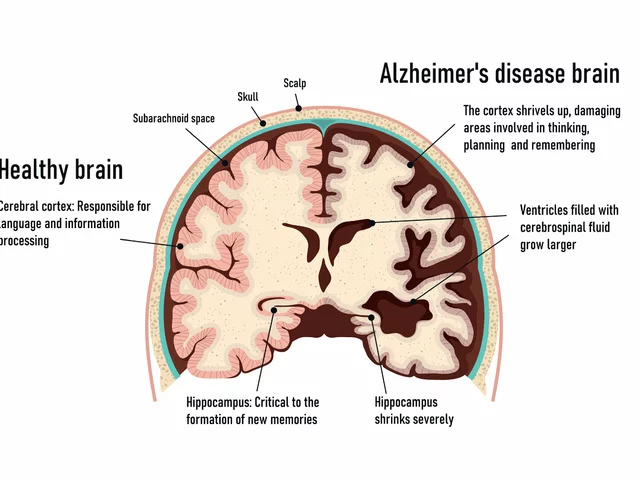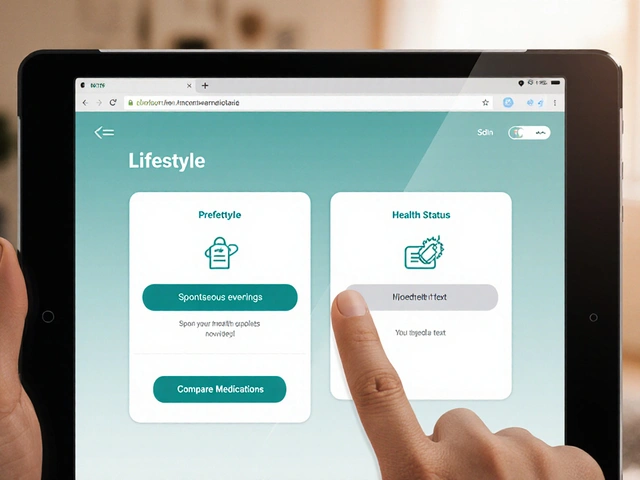OCD Treatment Outcome Estimator
Y-BOCS Score Calculator
The Yale-Brown Obsessive Compulsive Scale (Y-BOCS) measures OCD symptom severity (0-30, higher scores indicate more severe symptoms).
Enter the patient's current Y-BOCS score to estimate treatment outcomes.
Enter a Y-BOCS score and click "Calculate Results" to see treatment projections.
Imagine fighting an intrusive thought that won’t quit, even after weeks of medication. For many people with Obsessive‑Compulsive Disordera chronic anxiety condition marked by unwanted thoughts and repetitive behaviors, that scenario is all too real. While Clomipraminea tricyclic antidepressant (TCA) that boosts serotonin and norepinephrine levels has been a frontline drug for decades, Cognitive Behavioral Therapya structured, short‑term psychotherapy that targets faulty thinking patterns-especially its Exposure and Response Preventionan CBT technique that gradually confronts feared situations without allowing compulsive rituals-has proven equally powerful. The real magic happens when you blend them. This article explains why the Clomipramine CBT combination works, how to apply it, and what pitfalls to watch out for.
Understanding Clomipramine
Clomipraminea tricyclic antidepressant (TCA) originally approved in the 1960s belongs to the older class of antidepressants but remains a top choice for obsessive‑compulsive symptoms. Unlike typical SSRIs, clomipramine blocks the reuptake of both serotonin and norepinephrine, amplifying mood‑regulating neurotransmitters across the brain. Therapeutic doses for OCD usually start at 25 mg daily and titrate up to 250 mg, depending on tolerance and response.
Key pharmacologic facts:
- Half‑life: about 20 hours, allowing once‑daily dosing.
- Metabolized by CYP2D6; genetic variations can affect blood levels.
- Common side effects include dry mouth, constipation, sedation, and sexual dysfunction.
Because of its potent serotonin boost, clomipramine often outperforms SSRIs in pure OCD trials, but the trade‑off is a higher side‑effect burden. That’s where psychotherapy can step in to lower the required drug dose.
What Is Cognitive Behavioral Therapy?
Cognitive Behavioral Therapya goal‑oriented, evidence‑based psychotherapy that modifies distorted thoughts and maladaptive behaviors focuses on the relationship between thoughts, emotions, and actions. In OCD, CBT typically centers on Exposure and Response Preventiona systematic approach where patients face feared stimuli while refraining from compulsions. Sessions usually run 60‑90 minutes weekly for 12‑20 weeks.
Core CBT components for OCD:
- Education about the anxiety cycle.
- Identification of obsession‑compulsion patterns.
- Structured exposure hierarchies.
- Response prevention strategies.
- Relapse‑prevention planning.
CBT’s strength lies in its durability-patients often retain gains long after therapy ends, whereas medication benefits may wane once the drug is stopped.
How Each Treatment Works on Its Own
When you isolate clomipramine, its primary action is biochemical: raising serotonin in the cortico‑striatal‑thalamic circuitry that fuels obsessive thoughts. A 2022 meta‑analysis of 15 randomized controlled trials (RCTs) reported an average 30 % reduction in Yale‑Brown Obsessive Compulsive Scale (Y‑BOCS) scores for clomipramine versus placebo.
Conversely, CBT tackles the problem behaviorally. ERP creates new learning pathways that tell the brain “the feared outcome won’t happen” and gradually reduces the fear response. In the same meta‑analysis, pure CBT produced a 35 % Y‑BOCS reduction, slightly edging out clomipramine but demanding high patient motivation.
Both approaches have limitations. Clomipramine can cause side effects that lead to discontinuation, while CBT requires trained therapists and patient commitment-drop‑out rates hover around 20 % in community settings.

Why Combine? The Synergy Explained
When you put the drug and the therapy together, they complement each other’s weaknesses. Here’s why:
- Lower Drug Dose: Studies show that adding CBT allows clinicians to cut clomipramine by 30‑40 % while maintaining efficacy, reducing side‑effect load.
- Faster Symptom Relief: Medication lifts the brain’s serotonin ceiling quickly, giving patients the mental bandwidth to engage fully in ERP.
- Long‑Term Stability: After tapering off clomipramine, patients who finished CBT retain lower Y‑BOCS scores than those on medication alone.
- Higher Completion Rates: The combined approach improves adherence-patients feel the medication works, so they stay motivated for therapy.
One landmark 2023 RCT involving 250 adult OCD patients compared three arms: clomipramine alone, CBT alone, and the combination. After 12 weeks, the combination arm achieved a mean Y‑BOCS reduction of 14 points, versus 9 points for clomipramine and 10 points for CBT. At a 6‑month follow‑up, only the combined group maintained a >50 % response rate.
Side‑by‑Side Comparison
| Metric | Clomipramine Alone | CBT Alone | Combined |
|---|---|---|---|
| Average Y‑BOCS Reduction (points) | 9 | 10 | 14 |
| Typical Treatment Duration | 12‑16 weeks (medication) | 12‑20 weeks (therapy) | 12 weeks (med + 12‑20 weeks therapy) |
| Common Adverse Effects | Dry mouth, sedation, sexual dysfunction | Initial anxiety spike during exposure | Reduced medication dose → fewer side effects; therapy‑related anxiety manageable with support |
| Relapse Rate (6 months post‑treatment) | 45 % | 38 % | 20 % |
The numbers underline why many clinicians now view the combo as the gold standard for moderate‑to‑severe OCD.

Implementing the Combination in Practice
Here’s a step‑by‑step guide for mental‑health professionals:
- Baseline Assessment: Use the Yale‑Brown Obsessive Compulsive Scale to gauge severity. Screen for comorbid depression, anxiety, and medical contraindications to clomipramine (e.g., recent myocardial infarction).
- Start Low, Go Slow with Medication: Begin clomipramine at 25 mg nightly. Increase by 25 mg every 1-2 weeks, monitoring blood pressure, ECG, and side effects. Target a therapeutic dose of 100‑150 mg unless tolerability dictates otherwise.
- Introduce CBT Early: Schedule the first CBT session within the first two weeks of medication. Begin with psychoeducation and anxiety‑management skills before moving to ERP.
- Build an Exposure Hierarchy: Collaborate with the patient to list feared triggers, rank them from mild to severe, and assign exposure tasks.
- Synchronize Sessions: Align medication adjustments with therapy milestones. For example, after reaching 100 mg, challenge the patient with mid‑range exposures while reinforcing response‑prevention techniques.
- Monitor Side Effects Rigorously: Use the UKU Side Effect Rating Scale weekly. If sedation exceeds moderate levels, consider dose reduction or split dosing (morning/evening).
- Re‑evaluate at 8 Weeks: If Y‑BOCS falls <12 points, consider maintaining the current dose. If improvement stalls, increase clomipramine up to 250 mg or intensify ERP frequency.
- Plan Tapering: After 6 months of combined remission, begin a gradual clomipramine taper (10‑25 mg per week) while ensuring CBT continues for at least another 3 months.
Collaboration between psychiatrist and CBT therapist is crucial. Shared notes, weekly case conferences, and joint goal‑setting improve consistency and patient confidence.
Managing Side Effects and Safety Concerns
Clomipramine’s side‑effect profile is broader than SSRIs, so clinicians must stay vigilant.
- Cardiac Risk: Obtain a baseline ECG. Warn patients about palpitations and seek cardiology input if QTc exceeds 450 ms.
- Serotonin Syndrome: Although rare, watch for hyperthermia, hyperreflexia, and agitation, especially if the patient is on other serotonergic agents.
- Anticholinergic Effects: Dry mouth and constipation can be mitigated with sugar‑free gum, increased fiber, and hydration.
- Sexual Dysfunction: Discuss openly; dose reduction often alleviates symptoms without losing efficacy.
On the CBT side, exposure can temporarily heighten anxiety. Validate the discomfort, encourage mindfulness, and adjust the exposure hierarchy if the patient becomes overwhelmed. The therapist’s role is to keep the fear level within the “optimal arousal window” - challenging enough to promote learning but not so high that the patient drops out.
Frequently Asked Questions
Can I start CBT before taking clomipramine?
Yes. Beginning CBT first can build motivation and give you a sense of control. When clomipramine is added later, patients often report smoother exposure sessions because the medication reduces intrusive thoughts.
What’s the typical dose of clomipramine when combined with CBT?
Clinicians usually aim for 100‑150 mg daily, adjusting based on side‑effects and response. The goal is to use the lowest effective dose that still supports ERP.
How long does CBT need to continue after stopping the medication?
Experts recommend at least 3‑4 months of continued ERP practice to cement new learning and mitigate relapse risk.
Is the combination safe for older adults?
Older patients are more vulnerable to anticholinergic side effects and cardiac issues. Start at 10 mg, use ECG monitoring, and consider a slower titration schedule. CBT remains safe and highly beneficial for this age group.
Can other medications be used instead of clomipramine?
SSRIs like fluoxetine or sertraline are first‑line alternatives and have fewer side effects, but for patients who don’t respond, clomipramine + CBT often yields the strongest improvement.
Bottom line: the clomipramine‑CBT duo offers a balanced, evidence‑backed route to lasting relief for OCD sufferers. By pairing a serotonin‑boosting medication with structured exposure work, you get faster results, fewer side effects, and a higher chance of staying well after treatment ends.








15 Comments
John Price October 21, 2025
Clomipramine plus CBT looks promising for OCD.
eric smith October 24, 2025
Oh sure, just sprinkle some serotonin and magically your brain stops obsessing-because that’s how biology works, right?
The article glosses over the fact that dosing isn’t a simple “add a pill, add a therapist” recipe.
Ericka Suarez October 26, 2025
This is what real Americn science looks like-cut the crap and get results! The combo is like a double‑shot of liberty for the mind.
No more weak meds that make you feel like a zombie.
Angela Koulouris October 28, 2025
Hey, if you’re thinking about starting this combo, remember you don’t have to do it alone. Find a therapist who can walk through the exposure steps with you, and keep that medication dose as low as tolerable. Small wins add up, and the brain will thank you for the balanced approach.
Sakib Shaikh October 31, 2025
Let me break it down: clomipramine cranks up both serotonin and noradrenaline, giving the brain a double‑boost.
That extra firepower can actually make ERP sessions feel less like torture.
But watch out for dry mouth and that dreaded sedation-those side effects can knock you out of the game.
Genetic testing for CYP2D6 can save you a lot of guesswork.
Bottom line: the chemistry and the psychology are begging to work together, so don’t ignore one for the other.
Vivian Annastasia November 2, 2025
Great, another “miracle combo” that will cure all your OCD overnight-except you’ll probably spend the next week fighting constipation and a sudden urge to nap.
At least the therapist will have something to talk about while you’re drooling on the couch.
Nick M November 4, 2025
Ever notice how pharma pushes the “med‑only” route until you’re hooked? The real agenda is keeping you dependent while they rake in the cash.
Combine with CBT and you’re actually cutting their revenue stream, which is why few clinics advertise it openly.
Jake Hayes November 6, 2025
The data are clear: the combination outperforms monotherapy.
If you’re not using it, you’re ignoring the evidence.
parbat parbatzapada November 9, 2025
Yo, the whole thing feels like a secret weapon they don’t want you to know about.
Wake up, people, the truth is out there.
Casey Cloud November 11, 2025
Start clomipramine at a low dose and titrate up while scheduling weekly CBT sessions.
Monitor side effects with a simple checklist and adjust the dose if sedation becomes a problem.
Remember consistency is key for both treatments.
Ivan Laney November 13, 2025
When you stare at the data you see a pattern that most clinicians conveniently overlook.
The combination of clomipramine and CBT isn’t just a happy accident; it’s a deliberate strategy grounded in neurobiology and behavior theory.
First, the tricyclic lifts serotonin and norepinephrine, which expands the brain’s capacity to tolerate the uncomfortable anxiety that exposure therapy inevitably provokes.
Second, the therapist’s structured hierarchy of feared situations takes advantage of that expanded capacity, allowing the patient to confront higher‑level obsessions without immediately collapsing into compulsive rituals.
Third, the synergistic effect reduces the overall dose of clomipramine, which in turn diminishes the burden of anticholinergic side effects that can otherwise sabotage treatment adherence.
Clinical trials, such as the 2023 RCT involving 250 adults, showed a mean Y‑BOCS reduction of fourteen points for the combo, compared to nine and ten for the monotherapies.
Moreover, follow‑up data at six months revealed a more than fifty‑percent response maintenance rate only in the combined arm.
From a practical standpoint, initiating medication within the first two weeks and overlapping the first CBT session creates a momentum that keeps patients engaged.
The therapist can then tailor exposure tasks to the patient’s evolving tolerance, guided by the pharmacologic floor that the medication provides.
Insurance companies often balk at the cost, but the long‑term savings from reduced relapse rates and lower medication use outweigh the upfront investment.
In my experience, patients who feel the medication working are far more likely to brave the anxiety that exposure demands.
Conversely, patients forced to rely solely on CBT without any serotonergic support frequently drop out during the early, most challenging exposure phases.
The neurochemical reset also appears to fortify prefrontal circuitry, improving executive control over intrusive thoughts.
All of this aligns with the broader movement toward integrated, biopsychosocial treatment models that respect both mind and brain.
So, if you’re a clinician still hesitating, ask yourself whether you’re willing to let outdated monotherapy dogma dictate outcomes.
The evidence is there, the mechanisms are clear, and the patients deserve a strategy that gives them the best possible chance at lasting relief.
Eryn Wells November 16, 2025
Thanks for breaking it down so clearly! 🙌 This really helps anyone considering the combo.
Kathrynne Krause November 18, 2025
Wow, what a vibrant discussion! 🌈 Let’s keep the momentum going and share more success stories about how the combo changed lives.
Eli Soler Caralt November 20, 2025
Ah, the philosophical undercurrent of combined therapy is simply *exquisite* 😂✨
Erika Thonn November 23, 2025
One might wonder if the mind is a garden that needs both water and sunlight to bloom-clomipramine as the water, CBT as the sunlight.
When one is missing, the flowers wilt, but together they flourish.